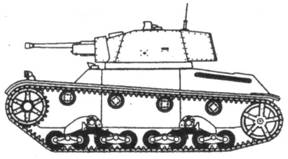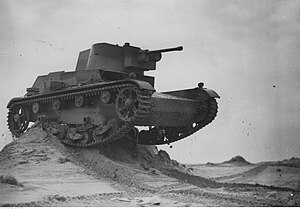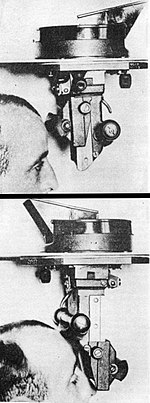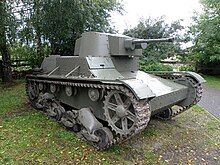
The T-26 tank was a Soviet light tank used during many conflicts of the Interwar period and in World War II. It was a development of the British Vickers 6-Ton tank and was one of the most successful tank designs of the 1930s until its light armour became vulnerable to newer anti-tank guns. It was produced in greater numbers than any other tank of the period, with more than 11,000 units manufactured giving it the title of the most produced tank during the interwar period. During the 1930s, the USSR developed 53 variants of the T-26, including flame-throwing tanks, combat engineer vehicles, remotely controlled tanks, self-propelled guns, artillery tractors, and armoured carriers. Twenty-three of these were series-produced, others were experimental models.

The TK (TK-3) and TKS were Polish tankettes developed during the 1930s and used in the Second World War.

The Vickers 6-ton tank or Vickers Mark E, also known as the "Six-tonner" was a British light tank designed as a private project at Vickers. It was not adopted by the British Army, but was picked up by many foreign armed forces. It was licensed by the Soviet Union as the T-26. It was also the direct predecessor of the Polish 7TP tank.

The Bofors 37 mm anti-tank gun was an anti-tank gun designed by Swedish manufacturer Bofors in the early 1930s originally for Swedish use. It was exported to several countries during the 1930s of which several bought licences to produce it themselves. The gun was used in several conflicts but most of its fame comes from its use in the Spanish Civil War and the Winter War where it was used very successfully against light tanks and armored cars among other targets. Beyond its use as an infantry gun it was also used as the main armament in several armored cars and tanks such as the Dutch M39 Pantserwagen and the Polish 7TP to name a few. As the armor of tanks was increased during World War II the gun very quickly became obsolete as an anti-tank gun but was still used effectively as an infantry support gun for the entirety of the war, and well into the Cold War. This was due to its high fire rate, great mobility and effective high explosive shells.
The Gundlach Periscope, usually known under its British designation as Vickers Tank Periscope MK.IV, was a revolutionary invention by Polish engineer Rudolf Gundlach, manufactured for Polish 7TP tanks from the end of 1935 and patented in 1936 as the Peryskop obrotowy Gundlacha. It was the first device to allow the tank commander to have a 360-degree view from his turret with a single periscope. By rotating the periscope and allowing the tank commander to look backwards through the second eyepiece, he no longer had to change position to look behind the turret. Early tanks had small turrets and fixed seating, without an independently rotating cupola, and so the commander wasn't easily able to move himself to another rear-facing periscope.
Janusz Magnuski (1933–1999) was a Polish author and military historian. His principal works document the development and deployment of Polish and Soviet armor utilized during World War II and he has been called "the world's most noted historian of Soviet tank history". He was one of the authoritative sources for documentation of the hardware on display in the Museum of the Polish Army located in Warsaw.

Pistolet maszynowy wz. 39 Mors was a Polish submachine gun designed by Piotr Wilniewczyc and Jan Skrzypiński between 1936 and 1938. It was to have become the standard submachine gun of the Polish Army some time in the 1940s. However, its production was halted by the 1939 Invasion of Poland and World War II.

The Battle of Tomaszów Lubelski took place from 18 September to 20 September 1939 near the town of Tomaszów Lubelski. It was the second largest battle of the Invasion of Poland and also the largest tank battle of the campaign. It resulted in the surrender of Army Krakow on 20 September 1939.

The Sokół 1000 was the heaviest Polish pre-war motorcycle manufactured by the PZInż works, for both civilian and military use by the Polish Army. Production of the model 1000 started in 1933 and lasted until the outbreak of World War II in 1939. A standard completion was a sidecar combination.

C7P was a Polish tracked artillery tractor, used by the Polish Army before and during World War II. The tractor was developed by the design bureau of Witold Jakusz of the PZInż company between 1931 and 1934.

The Ford FT B was the first production armoured car designed and built in Poland. Built on the chassis of the Ford T and armoured with re-used armoured plates, the car was a successful design for its time. The main designer was the engineer Tadeusz Tański. The armoured vehicle originated on account of the high demand during the Polish-Soviet war in 1920.

The 10TP was a Polish light cruiser tank that never left the prototype status. While advancing the Polish armour development programme, the prototype was deemed unsuccessful. Discoveries made during testing led to the design phase of the newer 14TP model, which was never completed due to the onset of World War II.
The Warsaw Armoured Motorized Brigade was a motorized unit of the Polish Army during the interbellum period. The brigade was one of two such units in Poland. Not fully formed by September 1, it was nonetheless partially combat ready and immediately rushed into battle during the Polish September Campaign. Following heavy losses during the Battle of Tomaszów Lubelski, it was disbanded on September 20, 1939.

9TP was a Polish light tank of early World War II era. A development of the earlier 7TP tank, it was to replace its predecessor in Polish service in 1940. Due to the outbreak of the war, only a limited number of early prototypes and development versions took part in battles of the Invasion of Poland.

This article deals with the history and development of tanks of the Polish army from their first use after World War I, into the interwar period, during World War II, the Cold War and modern era.

C2P was a Polish light artillery tractor. Designed in the 1930s, it was the basic tractor of Polish anti-aircraft artillery during the 1939 Nazi and Soviet invasion of Poland. There are only two surviving vehicles, both in private hands in Poland.

4TP, otherwise known as PZInż 140, was a Polish light tank prototype. It was designed by 16 December 1936 by Edward Habich of the Państwowe Zakłady Inżynieryjne works. A light reconnaissance tank, it was to become a heavier replacement for TK-3 and TKS tankettes in Polish service. In addition to light, manoeuvrable chassis, the tank was to feature a turret with one 20 mm nkm wz. 38 FK autocannon and one Ckm wz. 30 machine gun.

MOJ is a defunct brand of motorcycles that were manufactured in Katowice, Poland from 1937 to 1939. The name derives from the nickname of the founder, Gustaw Różycki, whilst he was a student at the University of Leoben.



















